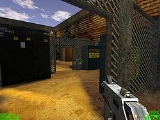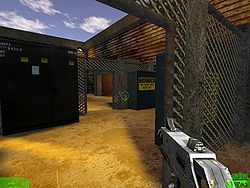
Retribution Engine
Encyclopedia
The Retribution Engine is a 3D
game engine
that is used to make first person shooter games. The engine is open source
and is supplied with a suite of editing tools that allow the development of customized games. The engine and the original game, Corridors of Power, are available for download from a range of websites (most notably demonews.com and TheGameHippo.com) and have been featured in news articles and software listings on notable sites such as opengl.org.
The engine has been in development for over a decade and has contributed over 150,000 lines of code to the open source community. The engine provides powerful features often only seen in commercial game engines without heavy reliance on third-party libraries. Thus it is highly customisable and also provides valuable educational information to anyone interested in writing 3D games.
and uses OpenGL
for rendering and DirectSound
for 3D sound effects. The install package includes a game launcher, the game engine, a level editor, a model editor, an episode editor and comprehensive documentation.
From this moment, the work became two related projects. Work continued on Corridors of Power and ran in parallel to continued development of the Retribution Engine. April 2001 saw the first public release of the tools and so allowed others to begin work on their own levels.
By August 2002 Corridors of Power was just another mod for the Retribution Engine. John Eriksson and Tom Methven joined the team and began development of the game ‘Dreamworld’ which eventually became ‘Sinister’. Gunrock was also in the process of developing several levels, two of which were ultimately released.
In August 2003 Corridors of Power was completed. From this time the official name of the project became the Retribution Engine and work concentrated on the development of the engine and tools while existing designers and new ones such as MitaMAN continued to develop new levels.
In December 2006 the project hit a number of difficulties and development ceased. But in June 2007 the engine was reborn as an open source project and with the hope that development might continue with the help of the open source community.
 The Retribution Engine is written to take full advantage of OpenGL accelerated transformation and lighting and supports high quality 32bit textures and lightmaps. It also makes full use of the DirectSound API to create realistic 3D sound effects. The use of a volume-based visibility system in conjunction with a static quad-tree terrain engine allows seamless transitions between indoor and outdoor areas.
The Retribution Engine is written to take full advantage of OpenGL accelerated transformation and lighting and supports high quality 32bit textures and lightmaps. It also makes full use of the DirectSound API to create realistic 3D sound effects. The use of a volume-based visibility system in conjunction with a static quad-tree terrain engine allows seamless transitions between indoor and outdoor areas.
The scripting system is dialog driven and so doesn’t require the designer to use a custom scripting language. This eases the learning curve and makes it possible to quickly create powerful scripted sequences.
The innovative weapon system uses generic types to speed and ease development. All the designer has to do is pick a generic type and then customise it in order to create a weapon. This system has allowed the development of over twenty distinct weapons thus far.
The engine features support for industry standard .x and .md2 model formats. Models can have various effects applied including shaders, glow maps and chrome maps.
The engine also supports various special effects including:
Multiplayer
Single Player Levels
Challenge Levels
Survival Levels
3D computer graphics
3D computer graphics are graphics that use a three-dimensional representation of geometric data that is stored in the computer for the purposes of performing calculations and rendering 2D images...
game engine
Game engine
A game engine is a system designed for the creation and development of video games. There are many game engines that are designed to work on video game consoles and personal computers...
that is used to make first person shooter games. The engine is open source
Open source
The term open source describes practices in production and development that promote access to the end product's source materials. Some consider open source a philosophy, others consider it a pragmatic methodology...
and is supplied with a suite of editing tools that allow the development of customized games. The engine and the original game, Corridors of Power, are available for download from a range of websites (most notably demonews.com and TheGameHippo.com) and have been featured in news articles and software listings on notable sites such as opengl.org.
The engine has been in development for over a decade and has contributed over 150,000 lines of code to the open source community. The engine provides powerful features often only seen in commercial game engines without heavy reliance on third-party libraries. Thus it is highly customisable and also provides valuable educational information to anyone interested in writing 3D games.
Description
The Retribution Engine is written by Andrew Gardner et al. and the editing tools were written by Paul Moxon. The engine is open source and is distributed under the GPL license. It is designed to run on WindowsMicrosoft Windows
Microsoft Windows is a series of operating systems produced by Microsoft.Microsoft introduced an operating environment named Windows on November 20, 1985 as an add-on to MS-DOS in response to the growing interest in graphical user interfaces . Microsoft Windows came to dominate the world's personal...
and uses OpenGL
OpenGL
OpenGL is a standard specification defining a cross-language, cross-platform API for writing applications that produce 2D and 3D computer graphics. The interface consists of over 250 different function calls which can be used to draw complex three-dimensional scenes from simple primitives. OpenGL...
for rendering and DirectSound
DirectSound
DirectSound is a software component of the Microsoft DirectX library for the Windows operating system. DirectSound provides a low-latency interface to the sound card driver and can handle the mixing and recording of multiple audio streams....
for 3D sound effects. The install package includes a game launcher, the game engine, a level editor, a model editor, an episode editor and comprehensive documentation.
- Game Launcher – this program scans the game directory for any games or levels, lists them and allows them to be launched in the game engine. It also allows various game engine parameters such as screen resolution to be configured.
- Game Engine – the game engine program is supplied with a range of textures, models and sounds that can be used to create freeware levels. It has been designed to be highly customisable without the need for programming knowledge.
- Level Editor – this powerful 3D design program allows complete worlds to be designed and populated with rooms, terrain, models, entities, etc.
- Model Editor – this program allows models in established industry formats to be imported and saved in a form that the game engine can understand and use. It also provides facilities to create textured models using a range of standard 3D shapes.
- Episode Editor – this program allows the designer to give a more individual and customised look to their levels.
History
Work on the Retribution Engine was begun by Andrew Gardner in 1997, inspired by games such as Doom and Quake and also John Bradley’s ‘Tumbling Tie-Fighter’ demo program. The original aim was to create a game titled Corridors of Power. The first public release of the game occurred in March 1999 and consisted of a simple two-level demo of the game. The game and engine were regularly updated and generated much interest. The biggest comment was that game designers would like to use the engine to make their own levels and so Paul Moxon joined the project to develop a level editor in October 2000.From this moment, the work became two related projects. Work continued on Corridors of Power and ran in parallel to continued development of the Retribution Engine. April 2001 saw the first public release of the tools and so allowed others to begin work on their own levels.
By August 2002 Corridors of Power was just another mod for the Retribution Engine. John Eriksson and Tom Methven joined the team and began development of the game ‘Dreamworld’ which eventually became ‘Sinister’. Gunrock was also in the process of developing several levels, two of which were ultimately released.
In August 2003 Corridors of Power was completed. From this time the official name of the project became the Retribution Engine and work concentrated on the development of the engine and tools while existing designers and new ones such as MitaMAN continued to develop new levels.
In December 2006 the project hit a number of difficulties and development ceased. But in June 2007 the engine was reborn as an open source project and with the hope that development might continue with the help of the open source community.
Engine features

The scripting system is dialog driven and so doesn’t require the designer to use a custom scripting language. This eases the learning curve and makes it possible to quickly create powerful scripted sequences.
The innovative weapon system uses generic types to speed and ease development. All the designer has to do is pick a generic type and then customise it in order to create a weapon. This system has allowed the development of over twenty distinct weapons thus far.
The engine features support for industry standard .x and .md2 model formats. Models can have various effects applied including shaders, glow maps and chrome maps.
The engine also supports various special effects including:
- Particle effects
- Volumetric fog
- Volumetric explosions
- Stencil shadows
- Weather effects (rain and snow)
- Damage decals
Game modes
Single Player- Standard mode – complete the level(s) by solving puzzles and killing enemies
- Challenge maps – complete the level as quickly as possible. Fastest times are recorded and can be compared with your friends.
- Survival maps – survive waves of enemies in a multiplayer type arena. Fastest completion times are recorded and can be compared with your friends.
Multiplayer
- Standard deathmatch – in development
Games and levels
Single Player Games- Corridors of Power - Author: A.P.Gardner, Original Release Date: 17/08/2003, Levels: 7
- Sinister (Part 1) - Author: Jon Eriksson, Original Release Date: 07/06/2004, Levels: 2
- The DEPOT - Author: MitaMAN, Original Release Date: 09/12/2005, Levels: 1
- Slime Pits (Corridors of Doom part 1) - Author: A.P.Gardner, Original Release Date: 25/02/2006, Levels: 1
- Arkeon - Under construction by Nex1 Games for 2010
Single Player Levels
- The Burning Pit - Author: P.Moxon, Original Release Date: 14/05/2001
- Ancient Complex - Author: A.P.Gardner, Original Release Date: 10/07/2001
- The Powerstation - Author: The Wolf, Original Release Date: 04/03/2002
- Space Station - Author: d-p[0mat, Original Release Date: 30/07/2002
- The Conveyor Project - The Wolf, Original Release Date: 12/12/2002
- Gloom Base - Author: Gunrock, Original Release Date: 19/07/2003
- The Attack - Author: Gunrock, Original Release Date: 11/05/2004
Challenge Levels
- CH-Warehouse - Author: Jon Eriksson, Original Release Date: 20/07/2004
- CH-Turret Run - Author: The Wolf, Original Release Date: 22/07/2004
- CH-Ambush - Author: A.P.Gardner, Original Release Date: 10/08/2004
- CH-Challenge Pack (CH-Balance, CH-Chess, CH-Crazy Maze) - Author: The Wolf, Original Release Date: 19/09/2004
Survival Levels
- SV-Survival Complex - Author: A.P.Gardner, Original Release Date: 27/10/2005
- SV-Farm - Authors: Jon Eriksson & A.P.Gardner, Original Release Date: 05/09/2006
External links
- http://www.apgsoftware.co.uk/retrib/
- http://sourceforge.net/projects/retribengine/

